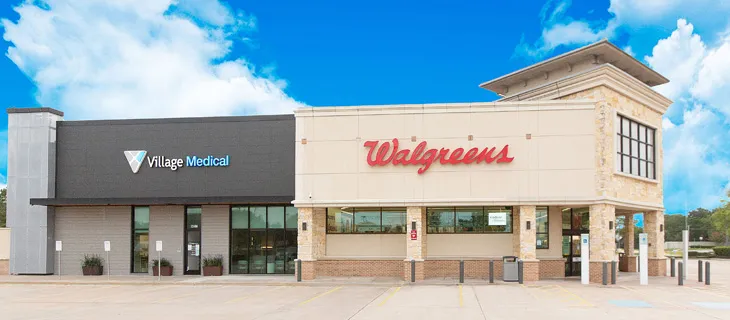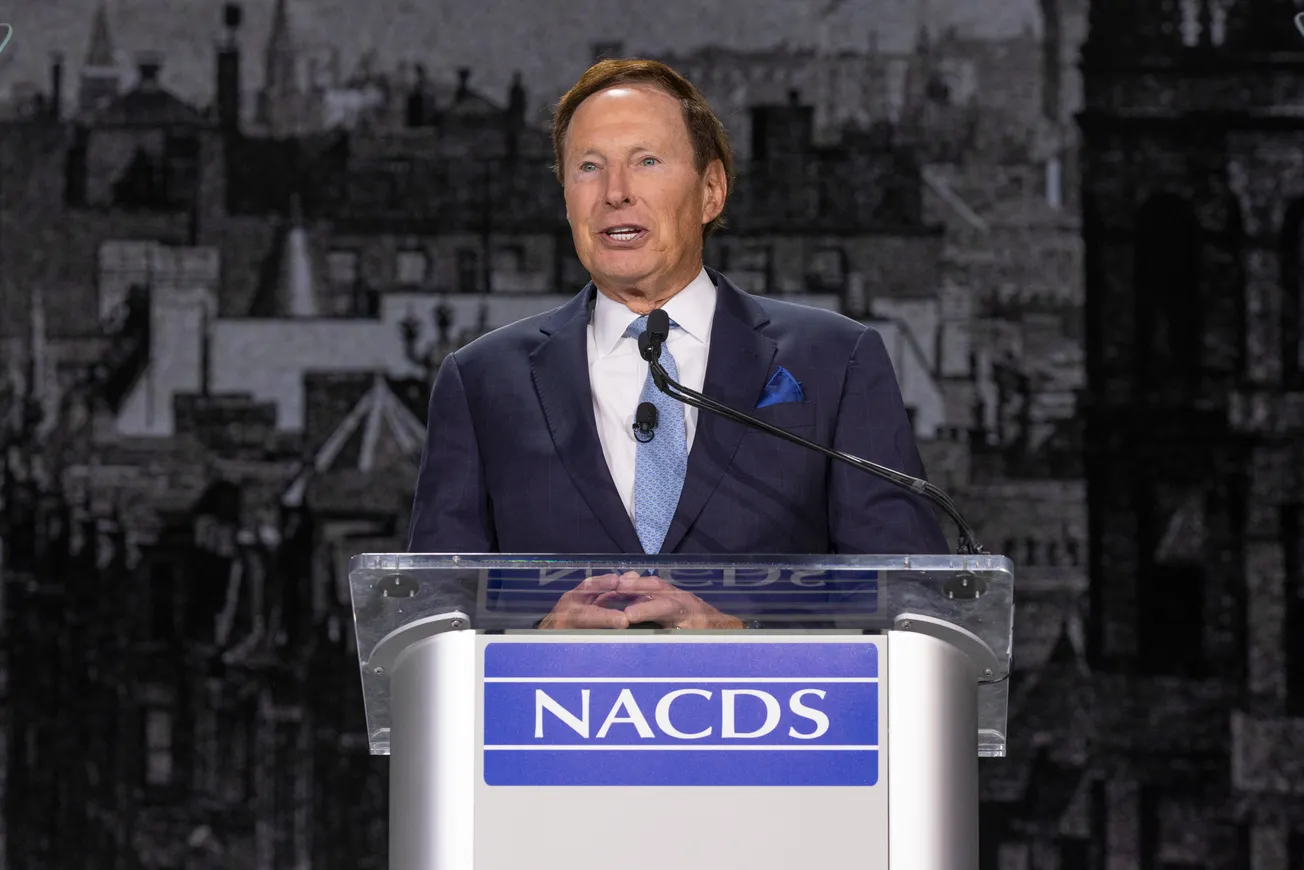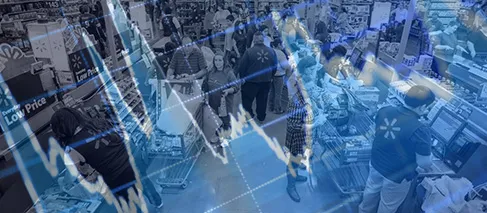DEERFIELD, Ill. — Walgreens Boots Alliance has spent the last several years assembling the components of a vast health care ecosystem, one that promises to enhance patient access, improve outcomes and lower overall costs. Today the company is aligning those assets — which include CareCentrix, a platform that coordinates care delivered in the home; Shields Health Solutions, a specialty pharmacy integrator for health systems; and primary, urgent and multispecialty care provider VillageMD — with its core pharmacy business to develop synergies that make the Walgreens offer greater than the sum of its parts.

John Driscoll
“Our job is to be a productive disruptor,” says John Driscoll executive vice president and president of U.S. Healthcare at WBA. “We’re going to be open to any solution that gets the consumer and the patient better and more convenient access to high-quality care at a lower price.
“The most exciting thing about our U.S. health care strategy is the Walgreens brand and what it represents. We’re definitely in the early stages of the transition to value-based health care, but if this were a baseball game, Walgreens would be starting on second base and aiming for home. We have millions of people every month who rely on our 9,000 stores and digital assets. We’ve got convenience, traffic and trust, so we start with access in a low-cost setting, and with a pharmacy and a retail team that really wants to solve problems for patients.”
Walgreens drug stores have been a pillar of community health care for more than a century, providing convenient access to medications, expertise on how they should be used, and advice on overall health and well-being. The new frontier for the company is primary care. Plans include the rollout of hundreds of Village Medical at Walgreens practices.
“Primary care is really an expansion of our value proposition where Walgreens is going to deliver better health care — in some cases, I would expect, urgent and specialty care as well as primary care,” explains Driscoll. “One of the things that anyone engaged with American health care knows is that the first things the system fails at are convenience and cost. By adding more direct care to the retail experience, our aim is to solve those problems. The addition of VillageMD enhances our basic value proposition.”
Those insights are the result of long-standing involvement in the health care business. Before joining WBA in October 2022, Driscoll served as chief executive officer of CareCentrix; president of Castlight Health, a technology company; and group president for new markets at Medco. He also was founder and chairman of the Surescripts electronic prescribing network.
“Our objective with VillageMD and with every one of our health care assets is around our total value proposition, and really to deliver on the promise of value-based care,” Driscoll says. “So when you think about our goal with Village Medical at Walgreens, it is not just to deliver year-over-year decreases in health care costs, but also to deliver better health outcomes and higher drug adherence.
“It’s the integration of the patient experience, the combination of omnichannel access to physical, digital, primary, specialty and ancillary care that we think we can really optimize. In the legacy Village Medical clinics, we are already delivering lower costs for our Medicare-eligible patients with better outcomes. We combine that with our integrated pharmacy experience, where we have a clinical pharmacist working directly with our physicians and patients at that VillageMD center. In a small pilot we’ve seen a 40% reduction in hospital readmissions over 30 days and a material A1C reduction in diabetic patients.”
Pharmacy remains the cornerstone of Walgreens’ business. As they have for decades, the company’s pharmacists are often the first line of defense when individuals encounter a health issue.

Rick Gates
Rick Gates, who started working at a drug store as a teenager and is now Walgreens chief pharmacy officer, says, “Being a pharmacist myself, I’ve always had a passion not only for what the profession does today, but where it can actually go to drive more value for consumers and the health care system, I view pharmacies as kind of the connective tissue of the health care ecosystem. Pharmacists see patients more commonly than physicians and other providers, and we really are there locally to help service patients’ needs.
“Walgreens has done a lot to advance the profession with programs in the adherence and new-to-therapy spaces, and those types of things. Changes in state scope of practice regulations are going to be important to really move pharmacy away from just the core dispensing of prescriptions and into care programs that help deliver improved outcomes for patients. Pharmacists are more than capable of doing things like testing for flu, strep or even COVID.
“Test and treat is the next opportunity for pharmacy. Empowering pharmacists to test and prescribe treatment means convenience and easier access to care for consumers, especially in underserved areas.”
Gates’ assertion about the potential of pharmacy was borne out by COVID. Members of the profession administered more than 300 million vaccine doses during the course of the pandemic, and were granted test-and-treat authority by the federal government for Paxlovid, an antiviral treatment.
“During the COVID emergency, when Walgreens put more than 70 million shots in arms, we were the front door to a public health system that we helped stand up,” Driscoll notes. “That validated our view that pharmacists and pharmacy are great access points and equipped to deliver care at scale.
“There’s no doubt that Walgreens is going to take advantage of the newly opened doors in community-based services and digital health that, as a result of the pandemic, consumers indicate they want and think we can provide.”
Maximizing the contributions of the company’s pharmacists is an integral part in that strategy. Toward that end, Walgreens is rolling out new technology and other tools to reduce routine tasks and free pharmacists and technicians to spend more time with patients.
“The multifaceted investments we’re currently making are critical for where we’re headed says Gates. “They include micro-fulfillment centers that take the filling of non-acute, maintenance-based medications largely out of the stores, as well as centralized call and chat centers for patients and centralized administrative support for pharmacists and technicians. A subset of our stores also have the ability to have calls answered centrally.
“We are looking at the store itself and maximizing the value of our pharmacy staff having more time to actually do the types of services that are going to tie into this larger Walgreens ecosystem. For me, it’s fun to look down that path and see what we can do to optimize how our stores are leveraging the micro-fulfillment centers. We want our pharmacy teams to develop programs that are relevant to the specific community they serve. Those efforts could involve adherence-based programs, or they could be things that we’re working on with pharmaceutical companies. They could be payer-based programs, like Buckeye Health Plan for Medicaid recipients in Ohio, or they could be the asthma and diabetes programs that we’re starting to stand up.”
 Pharmacy-based initiatives will be seamlessly integrated with the larger ecosystem being built by Walgreens Health. In addition to VillageMD, which Driscoll characterizes as a bold investment in value-based primary and specialty care, the company has plans to establish a presence beyond the walls of its drug stores and clinics.
Pharmacy-based initiatives will be seamlessly integrated with the larger ecosystem being built by Walgreens Health. In addition to VillageMD, which Driscoll characterizes as a bold investment in value-based primary and specialty care, the company has plans to establish a presence beyond the walls of its drug stores and clinics.
“We already have assets that allow us to extend our reach and relevance,” he says. “CareCentrix enables us to do home and community-based services in a network. Ultimately, Walgreens Health’s job is to meet demand for the new value-based health care, whether it’s in a retail location, through a physician-based solution, or through a nurse and home-based solution.
“When a hospital or health system works with Shields, they’re partnering with the highest adherent, best performing, specialty pharmacy for that high-need population. And so, again, we are meeting the demand for value-based care, which means better outcomes and lower costs, and it builds off of our core pharmacy strengths.
“At Walgreens, our strategy revolves around three questions: What can we do to leverage our drug stores in ways that deliver sensible solutions for problems that don’t have them today, in terms of either cost or quality? How do we leverage Walgreens in an integrated pharmacy, medical-care fashion in the community to take on risk? And how do we leverage our assets on a local level, whether it’s at a high-need, specialty hospital or community-based nursing services?”
The company also has ambitions to leverage its pharmacies and other assets to help consumers stay healthy and enhance their wellbeing.
“The first part of how we look at where pharmacy sits within the health care ecosystem is that our job is to help patients get on therapy, have optimized therapy, and live better and more healthy lives,” Gates explains. “When you think about it from that perspective, is there always going to be an acute care need that we have to solve for? Absolutely. People get sick, they’re going to need to come in and get antibiotics, do that type of thing. Do patients get diagnosed every day and come in and have to start therapy? Absolutely. We have stuff like that. But I think that preventative services as well as broader care programs to keep people healthy are absolutely where Walgreens needs to be.
“The advantage we have now is that we’re building a structure that delivers end-to-end care. So you have not just preventative services that we’re doing, but also looking at primary care, the ecosystem of keeping people healthy. You have post-acute care with CareCentrix on how we take care of patients after they get out of the hospital, and it ties into an ecosystem where pharmacy is a key component. That’s exactly what we’re building towards. Walgreens will play a major role in that going forward, because we’re really running fast to solve that.”










